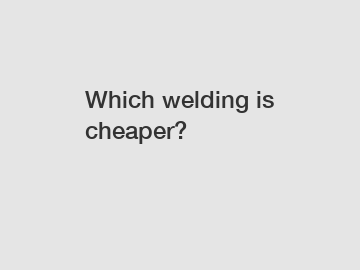Which welding is cheaper?
Which welding is cheaper?
One of the most common questions when it comes to welding is about cost. Many individuals and industries alike want to know which welding process is cheaper. After thorough research and analysis, the answer is clear: MIG (Metal Inert Gas) welding is generally cheaper than TIG (Tungsten Inert Gas) welding. .
The cost difference between MIG and TIG welding can be attributed to several factors. Firstly, MIG welding uses a consumable electrode wire that is continuously fed through the welding gun. This wire acts as both the filler material and the electrode. On the other hand, TIG welding uses a non-consumable tungsten electrode to create the arc, and a separate filler material must be added manually. The cost of the consumable electrode wire in MIG welding is typically lower than the cost of the filler rods used in TIG welding.

Additionally, MIG welding can be performed at a higher welding speed than TIG welding. This means that more work can be done in a shorter amount of time, resulting in lower labor costs. TIG welding, on the other hand, requires a slower and more precise technique, which can increase the overall production time and labor costs.
Furthermore, MIG welding is generally easier to learn and master compared to TIG welding. The simplicity of the MIG welding process allows for a higher level of automation, reducing the need for skilled welders. This can lead to significant cost savings, especially in industries that require large-scale welding operations. TIG welding, on the other hand, requires a higher level of skill and precision, often necessitating the employment of more experienced welders, which can increase labor costs.
The cost difference between MIG and TIG welding is significant and can have a substantial impact on various industries. For example, in the automotive industry, where high-speed production is essential, MIG welding is often the preferred choice due to its lower cost and faster welding speed. On the other hand, TIG welding is commonly used in applications that require precise and high-quality welds, such as aerospace and medical equipment manufacturing, where the cost difference is outweighed by the need for superior weld quality.
In conclusion, MIG welding is generally cheaper than TIG welding. The lower cost of consumable materials, higher welding speed, and ease of automation contribute to the cost advantage of MIG welding. However, it is essential to consider the specific requirements of each project or industry when deciding which welding process to choose. The cost savings provided by MIG welding may be outweighed by the superior quality and precision offered by TIG welding in certain applications. Ultimately, the decision should be based on a careful evaluation of cost, quality, and production requirements.
Contact us to discuss your requirements of inductionhfwelder.com, cnc induction hardening equipment, superaudio frequency annealing equipment. Our experienced sales team can help you identify the options that best suit your needs.


